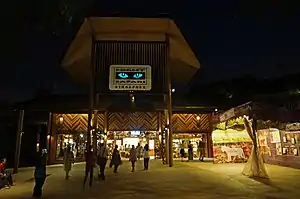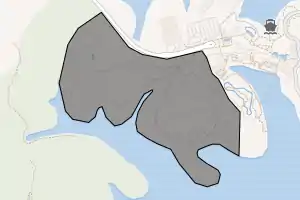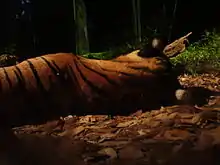Night Safari, Singapore
The Night Safari is the world's first nocturnal zoo and is one of the most popular tourist attractions in Singapore.
 | |
 Entrance of the Night Safari 
| |
| Date opened | 26 May 1994 |
|---|---|
| Location | Mandai, Singapore 80 Mandai Lake Road, Singapore 729826 |
| Coordinates | 1.402260°N 103.787886°E |
| Land area | 35 ha (86 acres)[1] |
| No. of animals | 900[1] |
| No. of species | 100[1] |
| Annual visitors | 1,321,718 (FY 2019/20)[2] |
| Major exhibits | 59 |
| Website | Night Safari |
The concept of a nocturnal park in Singapore was suggested in the 1980s by the former executive chairman of the Singapore Zoo, Dr Ong Swee Law. Constructed at a cost of S$63 million, the Night Safari was officially opened on 26 May 1994 and occupies 35 hectares (86 acres) of secondary rainforest adjacent to the Singapore Zoo and Upper Seletar Reservoir.
The Night Safari currently houses over 900 animals representing over 100 species, of which 41% are threatened species.[1] The Night Safari is managed by Wildlife Reserves Singapore, and about 1.3 million visitors visit the safari per year.[3][2] The Night Safari received its 11 millionth visitor on 29 May 2007.
Tram safari
The tram safari is the most popular attraction at the Singapore Night safari, and is a 40 minute drive through six geographical zone's. The geographical zones replicate a variety of habitats, ranging from the Himalayan foothills to Asian riverine forest. The drive thru has many free range habitats. Cattle grids are laid before and after the free ranging drive-thru habitats to prevent the animals from escaping. These are the six geographical zone's and the animals inhabiting:
Himalayan foothills
The himalayan foothills exhibits wildlife inhabiting the mountainous terrain of the Himalayas and replicates the natural habitats using rugged terrain, rocky outcrops.
Animals
Marshlands
The tram descends from the himalayan foothills to the marshlands. The marshlands has a very large pond for flamingoes and a swamp-based exhibit for otters.
Animals
- Greater Flamingo
- Asian Small-Clawed Otter
Indian subcontinent
The next region replicates the diverse landscape of the Indian subcontinent. The Indian subcontinent zone begins with a drive-thru through the free-ranging deer habitat.
Animals
Equatorial Africa
The tram further moves to the plains of the African Savannah. Most of the star animals of the Night safari tram route are located in this zone.
Animals
Asian riverine forest
The tram then moves into a heavily vegetated and lush rainforest habitat. This zone is located outside the night safari's main complex and replicates the rainforests of Malaysia.
Animals
- Babirusa
- Malayan Tapir
- Barking Deer
- Dhole
- Bornean Bearded Pig
- Asian Elephant (The Night safari's herd consists of six individuals, three females, two adult males and one calf. 'Chawang', the 45-year old male elephant is the star attraction and mascot off Night Safari.)
- Sambar Deer
Nepalese River valley
The next Nepalese River valley habitat has the most number of free ranging drive-thru habitats.
Animals
Burmese River valley
Burmese River Valley is the last geographical zone of the tram safari route featuring the rare wildlife of the Burma region and the Malay peninsula.
Animals
Exhibits
Walking trails
The park is divided into four walking trails which can be accessed by foot and species of nocturnal animals which cannot be seen by the tram can be seen through the walking trails. Visitors can watch the nightly routine of nocturnal animals unfold.
Fishing cat trail
Fishing cat trail is the first walking trailand it is the trail with some off the most unique nocturnal creatures. Most of the species in display at the Fishing cat trail are native to Singapore. The fishing cat trail is set in a dense primary rainforest. An interactive ranger station displaying information about wildlife native to Singapore is located near the explorer's outpost.
Animals
- Himalayan Tahr
- Spectacled Owl
- Binturong
- Fishing Cat
- Southern three-banded armadillo
- Kinkajou
- Giant Anteater
- Capybara
- Maned Wolf
- Barking Deer
- Greater mouse-deer
- Lesser mouse-deer
- Sunda Pangolin
- Common Palm Civet
- Indian Gharial
- Black pond turtle
- Asian Small-Clawed Otter
- Striped Hyena
Marsh birds
There is a large Marsh birds aviary along the fishing cat trail with full sized viewing windows displaying assorted wetland avifauna.
Animals
Leopard trail
Leopard trail is the largest and probably the best walking trail in the Night safari and exhibits wildlife indigenous to Southeast Asia. The leopards at the Night safari are managed under the European Endangered Species Programme, the leopard have been successfully bred and sent to zoos at different places for international breeding programmes under Wildlife Reserves Singapore.
Animals(Lion Lookout)
Animals(Main trail)
- Sri Lankan Leopard
- Masked Palm Civet
- Binturong
- Spectral Tarsier
- Small-toothed palm civet
- Leopard Cat
- Indian Crested Porcupine
- Malayan Porcupine
- Buffy Fish Owl
- Spotted Wood Owl
- Northern Luzon Giant Cloud Rat
- Bengal Slow Loris
- Asian Small-Clawed Otter
- Hog badger
- Giant pangasius
- Wallago attu
- Chital
- Collared Owlet
- Sunda Scops Owl
Animals(Owl Walkthrough)
- Common Barn Owl
- Spotted Whistling Duck
Mangrove walk
Mangrove walk is a free flight, rainforest themed walk-thru habitat. Night safari's flying foxes were relocated into this exhibit as their old habitat is now renovated to the new Owl Walkthrough exhibit.
Animals
- Malayan Flying Fox
- Lesser dog-faced fruit bat
- Red and White Giant Flying Squirrel
- Spotted Giant Flying Squirrel
- Indian Spotted Chevrotain
East Lodge trail
The East Lodge trail located along the East Lodge of the night safari is one of the most exciting walking trails. The theme of the trail is Africa-meets Asia . The trail is mostly made up off a basic walkway and three sheltered exhibits.
Animals
- Aardvark
- Sloth bear
- Spotted hyena
- Bongo
- Nile hippopotamus
- Babirusa
- Lowland anoa
- Red river hog
- Malayan tiger
Wallaby trail
The wallaby trail opened in 2013 to exhibit Australasian marsupial species from Australia, Papua New Guinea and New Zealand. The trail begins with the wallaby trail ranger Station displaying information about marsupials and Australian birds with stuffed specimens. The wallaby trail has another walk-thru habitat for wallabies.
Animals
Naracoorte cave
The naracoorte cave is Singapore's first man-made cave and houses denizens of invertebrates through terrariums embedded in the walls of the cave. The cave is full of stalactites and stalagmites, and cascading limestone walls. The cave also has a waterfall and an articial explorer's camp and various interactive displays.
Animals
Highlights

Unlike traditional nocturnal houses, which reverse the day-night cycle of animals so they will be active by day, the Night Safari is an entire open-air zoo set in a humid tropical forest that is only open at night. It is divided into seven geographical zones, which can be explored either on foot via four walking trails, or by tram.
The animals of the Night Safari, ranging from chital deer and gaur to Indian rhinoceros and pangolins to lions and Asian elephants, are made visible by lighting that resembles moonlight. Although it is brighter than full moonlight by a few orders of magnitude, it is dim enough not to disturb nocturnal and crepuscular animals' behaviour. London based lighting designer Simon Corder created the lighting for Night Safari.
The naturalistic enclosures simulate the animals' native habitat. Animals are separated from visitors with natural barriers, rather than caged, similar to the Singapore Zoo's open concept. Instead of vertical prison-like cages, cattle grids were laid all over the park to prevent hoofed animals from moving one habitat to another. These are grille-like metal sheets with gaps wide enough for animals' legs to go through. Moats were designed to look like streams and rivers to enable fishing cats and servals to be put on show in open areas, and hot wires were designed to look like twigs to keep animals away from the boundaries of their enclosures.
Cultural performances are a regular feature at the safari, and include tribal dances, blowpipe demonstrations and fire eating displays.
Thumbuakar Performance
This show is performed by trained actors acting as tribe members of Africa. The actors amaze viewers by dancing amd "eating" fire. By drinking a certain hydrogenised formula, they can put on a magnificent fire-blowing act.
Creatures of the Night Show
This show is a performance presented by the animals in the Night Safari. Civets show of their excellent sense of smell, a spotted hyena displays its powerful jaws, otters spread awareness to recycle reusable items and many more animals.
Food and beverage outlets in the Night Safari include Ulu Ulu Safari Restaurant, Bongo Burgers, and Casa Italia. Visitors can dine in the "Evening in the Wild" at Night Safari's only Tepee Tent. Also experience dining on the move with the Cocktail Safari Express and Gourmet Safari Express.
Awards
- ASEAN Tourism Association — Aseanta Awards For Excellence (1995)[3]
- Best New Attraction in ASEAN
- Singapore Tourism Awards[5]
- Top 10 Best Family Experience (2006)
- Best Leisure Attraction Experience (2003, 2004, 2006)
- Leisure Attraction of the Year (1996, 1997, 1999, 2000)
- Best Trail Marshall of the Year, Mohammed Munzir Aziz. (2008)
- Best Trail Marshall of the Year, Mohammad Ridhwan Shahril. (2009)
- Best Ground crew of the Year, Vijayeswaran Visvalingam. (2009)
- Best Animal Caretaker of the Year, Hadi Akmal (2015)
Transportation
Night Safari is not served directly by any MRT line, with the nearest station being the upcoming Springleaf MRT station.
There are three bus services operated by SBS Transit and SMRT Buses which calls at the bus stop near to the Zoo.[6]
| Service | Destination | Notes | |||
|---|---|---|---|---|---|
| SBS Transit Services | |||||
| 138 | Ang Mo Kio Bus Interchange | ||||
| SMRT Buses Services | |||||
| 926 | Woodlands Temporary Bus Interchange | Suspended till further notice | |||
| 927 | Choa Chu Kang Bus Interchange | ||||
Bus
A shuttle service, known as the Mandai Khatib Shuttle, plies daily between Khatib MRT station and the Zoo. A one-way trip cost $1 for everyone above the age of three.[7]
References
- "About Night Safari". www.wrs.com.sg.
- "WRS Yearbook 2018/2019" (PDF). Wildlife Reserves Singapore.
- "About Night Safari". www.wrs.com.sg.
- "Night Safari Naracoorte Cave". Retrieved 18 November 2020.
- Welcome to Singapore Tourism Awards 2008
- "Getting here". www.wrs.com.sg.
- Chew, Hui Min (9 March 2017). "New daily express bus from Khatib to Mandai wildlife parks". The Straits Times. Retrieved 9 March 2017.
- Lin Xinyi, "Night Safari: From trailblazer to tourism icon", The Straits Times, 31 May 2007
External links
| Wikimedia Commons has media related to Night Safari, Singapore. |